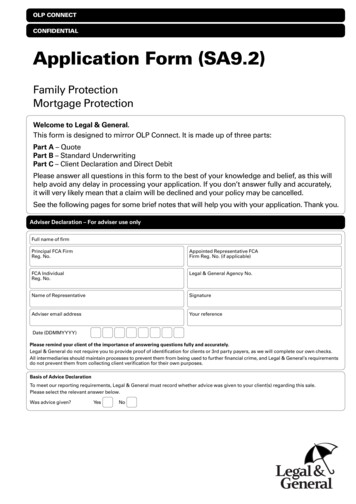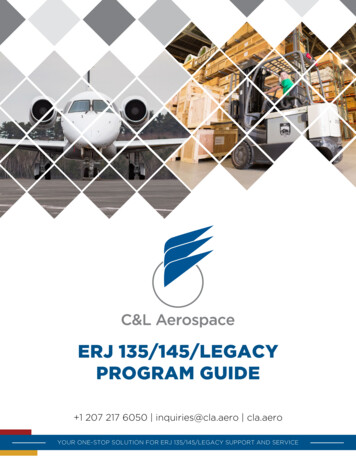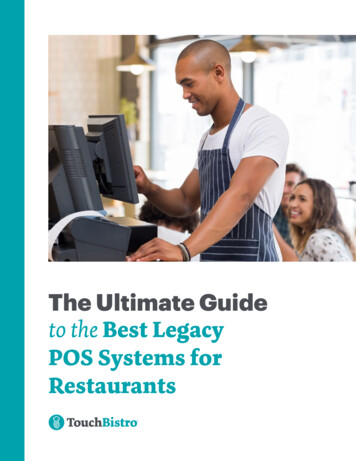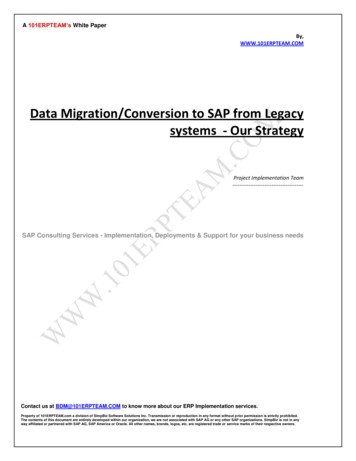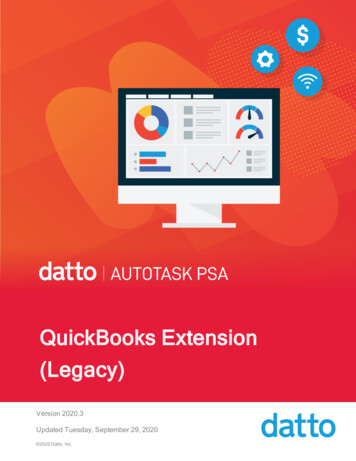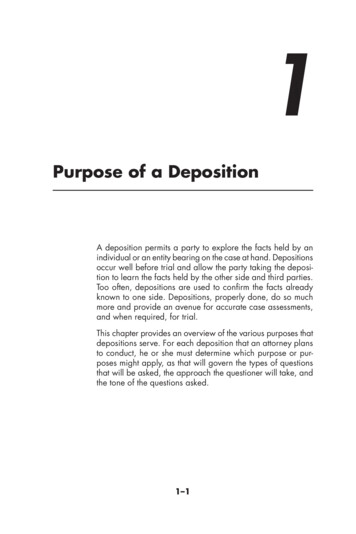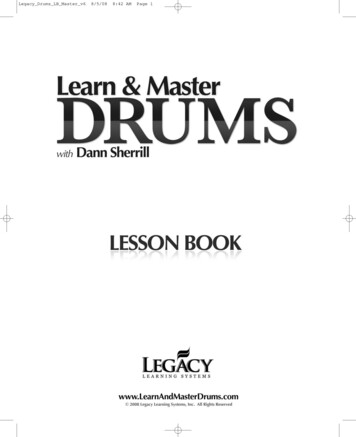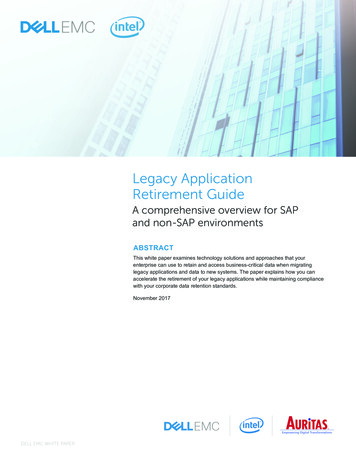
Transcription
Legacy ApplicationRetirement GuideA comprehensive overview for SAPand non-SAP environmentsABSTRACTThis white paper examines technology solutions and approaches that yourenterprise can use to retain and access business-critical data when migratinglegacy applications and data to new systems. The paper explains how you canaccelerate the retirement of your legacy applications while maintaining compliancewith your corporate data retention standards.November 2017DELL EMC WHITE PAPER
TABLE OF CONTENTSINTRODUCTION . . . . . . . . . . . . . . . . . . . . . . . . . . . . . 1CONSIDERATIONS FOR A LEGACY APPLICATIONRETIREMENT SOLUTION . . . . . . . . . . . . . . . . . . . . . . .Scalable architecture . . . . . . . . . . . . . . . . . . . . . . . . . .Cost-effective architecture . . . . . . . . . . . . . . . . . . . . . . .Ability to extract and store data from a variety of systems . . . . . . .Enterprise-level security . . . . . . . . . . . . . . . . . . . . . . . .Ease of use and flexible reporting . . . . . . . . . . . . . . . . . . .Data governance and retention compliance . . . . . . . . . . . . . .1122222STRATEGIES FOR LEGACY APPLICATION RETIREMENT . . . . . 3LEGACY APPLICATION RETIREMENT BY CAPTURING DATAIN A LOW-COST DATABASE . . . . . . . . . . . . . . . . . . . . . . 4Extract, transform and load . . . . . . . . . . . . . . . . . . . . . . . . . . . 5Security . . . . . . . . . . . . . . . . . . . . . . . . . . . . . . . . . . . . . 5Data governance and retention compliance . . . . . . . . . . . . . . . . . . 5LEGACY APPLICATION RETIREMENT PROCESS . . . . . . . . . . 5Discovery Phase . . . . . . . . . . . . . . . . . . . . . . . . . . . . . . . . 5Design Phase . . . . . . . . . . . . . . . . . . . . . . . . . . . . . . . . . . 5Build Phase . . . . . . . . . . . . . . . . . . . . . . . . . . . . . . . . . . . 5Go-live Phase . . . . . . . . . . . . . . . . . . . . . . . . . . . . . . . . . . 5INFRASTRUCTURE DEPLOYMENT OPTIONS . . . . . . . . . . . . 6Extract . . . . . . . . . . . . . . . . . . . . . . . . . . . . . . . . . . . . . 6Transform . . . . . . . . . . . . . . . . . . . . . . . . . . . . . . . . . . . . 7Store and report . . . . . . . . . . . . . . . . . . . . . . . . . . . . . . . . 7On-premises options . . . . . . . . . . . . . . . . . . . . . . . . . . . . . . 8Hybrid and cloud options . . . . . . . . . . . . . . . . . . . . . . . . . . . . 8ACCELERATING YOUR JOURNEY WITH DELL EMCAND AURITAS . . . . . . . . . . . . . . . . . . . . . . . . . . . . . . 8ABOUT THE AUTHORS . . . . . . . . . . . . . . . . . . . . . . . . . .9The information in this publication is provided “as is.” Dell Inc. makes no representations or warranties of any kind with respect to theinformation in this publication, and specifically disclaims implied warranties of merchantability or fitness for a particular purpose.Use, copying, and distribution of any software described in this publication requires an applicable software license.Copyright 2017 Dell Inc. or its subsidiaries. All Rights Reserved. Dell, EMC, and other trademarks are trademarks of Dell Inc.or its subsidiaries. Intel, Xeon and the Intel logo are trademarks of Intel Corporation in the U.S. and/or other countries. Other trademarksmay be the property of their respective owners. Published in the USA November 2017, White Paper.Dell EMC believes the information in this document is accurate as of its publication date. The information is subject to changewithout notice.DELL EMC WHITE PAPER
INTRODUCTIONImagine you’re the CIO of a large multinational company. You and your forward-thinkingteam have implemented a shiny new ERP application that replaces many of your olderapplications and offers great benefits in terms of efficiency and cost savings. Suddenly, anew problem arises before the cleaning crew even has a chance to clear out the remnantsof last night’s celebration party. What do you do with all those old applications that havebeen replaced?Though you migrated your master data and open transactions to the new applications, youstill have historical data in the old applications. These old, or legacy, applications containdata that your legal department insists on keeping available for audits. So, should you keepthe legacy applications running?As you grapple with this problem, your company makes a few acquisitions and informsyou that the new ERP system must be rolled out to them as well. You now have numerouslegacy applications that need managing. Before you know it, maintenance costs haveballooned, data governance has weakened, and your IT team must support a variety ofapplications that no one really knows much about.Your challenge is that once the master data and open transactions have been migratedto newer applications, the value of the data remaining in your older applications doesn’tjustify the costs of maintaining them. What then, are your options? How do you comply withlegal requirements and demands for historical data without incurring the huge licensing,maintenance and personnel costs?In such cases, instead of pulling their hair out, smart managers like you pull the plug onthese old applications by migrating essential data to a cost-effective repository with reportingcapabilities. This paper will help you understand how to design and build cost-effectivesolutions to overcome your legacy applications retirement problem.CONSIDERATIONS FOR A LEGACY APPLICATIONRETIREMENT SOLUTIONOnce you’ve diagnosed the need to retain legacy data for future retrieval, it’s time to thinkabout the ROI of available options. In many organizations, the retrieval of legacy data ispurely necessary for legal purposes. Practicality is key in selecting a retirement solution forretaining data. Why pay premium costs for access to data with little operational value? Inmost cases, if the cost of the application retirement solution is less than that of maintaining alegacy application, then a retirement solution wins out.When the value of retaining legacy data is low, organizations pursue cost-effective solutionsthat provide the following features:SCALABLE ARCHITECTUREWhether an organization chooses to host its legacy data on premises or in the cloud, thearchitecture should be highly scalable. Data growth and accessibility are the primary factorsin scalable architecture. If more legacy applications are to be retired, the implementedinfrastructure solution should scale to meet future requirements.1DELL EMC WHITE PAPER
COST-EFFECTIVE ARCHITECTUREOne of the main drivers for legacy application retirement is their high cost of maintenance.Also, the data from legacy applications is not perceived as very high in value as it’s mostlyretained for legal and compliance reasons. While the cost of non-compliance and notadhering to legal requirements can be high, the value for the day-to-day operations of theorganizations is minimal. This suggests that the replacement should have a low cost ofmaintenance.ABILITY TO EXTRACT AND STORE DATA FROM A VARIETY OF SYSTEMSLegacy systems come in a variety of shapes and sizes. Some use databases and openrelational tables for their back ends, while others use flat files and proprietary formats tostore their data. The proposed legacy application retirement solution should be capable ofextracting data from a variety of sources, such as: Relational database management systems (RDBMSs) Flat files Applications (SAP, Oracle E Business Suite, PeopleSoft, etc.) REST APIs JSON streamsThe system should allow data to load seamlessly. Extract, transform and load (ETL)features, such as auto-detection of source schemas and automatic transformation to thetarget schema, make the ETL process simple and time-efficient. Such features are essentialin a legacy application retirement solution.ENTERPRISE-LEVEL SECURITYTypically, data that is available in the legacy system is controlled by the application’s securityfeatures. Because these restrictions still apply when the data is moved into a new system, thelegacy application retirement solution should be security enabled to integrate with enterprisesecurity systems. In cases where the legacy application retirement solution will be activelyused by many users, it should support interfacing with Active Directory (AD) and LightweightDirectory Access Portal (LDAP), and support security features such as single sign-on.EASE OF USE AND FLEXIBLE REPORTINGLegacy data will frequently be retrieved for legal requirements and analytic purposes.To support these tasks, the system should provide strong visualization and reportingcapabilities. Developers and end users should have access to tools that allow them toquickly create custom reports.DATA GOVERNANCE AND RETENTION COMPLIANCELike security, data governance applies to all data retained by the organization. Whileorganizations are legally forced to retain data for certain periods of time, they are also legallyforced to remove and delete data that is older than the specified retention period. Therefore,the legacy retirement solution should offer robust lineage tracking, monitoring and retentioncompliance. To support auditing, the system should allow easy tracking and lineagereporting for the data stored in the legacy system. To enable retention compliance, thesystem should incorporate automatic rules to delete data subject to retention requirementsand integrity rules.2DELL EMC WHITE PAPER
STRATEGIES FOR LEGACY APPLICATION RETIREMENTGiven the above considerations, there are many strategies that organizations can adoptdepending on the individual organization’s needs. The table below lists some of thestrategies and their pros and cons:StrategyMigrate data from legacy environments intoactive systemsCapture data in magnetic formats and shutdown serversPros Single solution for accessing all information Expensive Having one platform for managingcompliance, security, etc. ROI of retaining legacy data does not justifyexpense Savings on hardware and softwaremaintenance Potential issues with hardware compatibility Reduction in data maintenancerequirements Inflexible Easier maintenance of databaseCapture data in a low-cost database Reporting on data is fast and easy Using database queries for reporting orODBC connection for external reporting Static report outputCapture all the information in a report formatCons Details accessible at a short notice Very little or no management needs Longer lead time for information access Migrating data into a database is a difficultprocess Effort required to build relationships totables in new database Effort required to create new reports Potential issues with data integrity andformat Capturing reports does not guarantee thatall historical data requirements will be met Issues with reporting performance anddisplay format Little flexibility on drill-down, mining andanalysis Capturing reports does not guarantee thatall historical data requirements will be metCapture data in a business warehousesolution Dynamic report outputs Details of data are quickly accessible User training required and purchase ofsoftware and hardware needed Cost of migration and maintenancecould be high Minimum user training requiredCapture data using tools like DART Single application for accessing legacyand active data Data is still mutually exclusive Only used for retiring SAP landscape Purchase of ILM software and hardwarerequired Understanding of fields and tablesknowledge is required for migration andreporting Built-in extraction processMigrate data into third-party tools (Informatica,OpenText, HPE, IBM, Business Objects etc.) Single application for retiring multiplelegacy environments Data is still mutually exclusive Retention management and datatagging possible3DELL EMC WHITE PAPER Software and hardware investment Knowledge transfer and training Proprietary solution
LEGACY APPLICATION RETIREMENT BY CAPTURINGDATA IN A LOW-COST DATABASECapturing legacy data in a low-cost database is a proven, cost-effective and flexible solutionadopted by various organizations. In this section, we highlight how Apache Hadoop canbe used as a low-cost database to capture legacy data.Apache Hadoop is an open-source, distributed computing platform that supports scalabledata storage, processing and analytics. One of the key features of Hadoop is that, toachieve scalability, the system is designed to handle failure of its nodes. The upside of this isthat less expensive hardware can be used to build the system. This leads to a cost-effectiveand highly scalable system.Since its early development stages, Hadoop’s ecosystem of components has grownabove and beyond primary components such as HDFS (Hadoop Distributed File System),MapReduce and YARN. The ecosystem now provides various components that helpHadoop deliver many of the legacy application retirement solution requirements discussedearlier. These features, in addition to low-cost and scalability benefits, make Hadoop anideal solution for legacy application retirement.The following sections provide details on how Hadoop proves to be a scalable, secure andcost-effective legacy application retirement solution.Lifecycle management, lineage & traceability,and retention compliance with FalconData port intoHive tablesHadoop HDFSDirect filetransfer toHadoop HDFSSparkImport data from files,RDBMS, No SQL, JSONusing Spark and store inHive or HDFSNo SQLRDBMSFiles4DELL EMC WHITE PAPER
EXTRACT, TRANSFORM AND LOADThe Hadoop eco-system has numerous components that support extraction and dataloading from multiple sources. For example, Hadoop’s HDFS allows direct file transfer oftext files to the HDFS. Hadoop also features additional tools to extract data from RDBMSs,NoSQL databases and JSON files.SECURITYTo meet regulatory requirements for data protection, Hadoop provides secure authenticationfor shared clusters. Hadoop in conjunction with Kerberos, a mature open-source networkauthentication protocol, authenticates users and provides access to data and functionswithin Hadoop.DATA GOVERNANCE AND RETENTION COMPLIANCEWhile Hadoop in itself does not provide many governance features, through its components itprovides an extensible set of core foundational governance services. These enable enterprisesto effectively and efficiently meet their compliance requirements within Hadoop by allowingintegration with the whole enterprise data ecosystem. Some of the features provided by theHadoop ecosystem include data lifecycle management; defining, scheduling and monitoringdata management policies; data lineage and traceability; auditing; and data classification.The above features make Hadoop an exceptional legacy system retirement solution.LEGACY APPLICATION RETIREMENT PROCESSProcess makes perfect! A strong process helps ensure the success of the legacy applicationretirement initiative. Below is an outline of a customizable process to meet the requirementsof various organizations:DISCOVERYDISCOVERY PHASE1. Identify all stakeholderswithin and outside theorganization. Stakeholdersoutside the organizationwould be regulatory bodiesand similar entities.2. Determine business valueof applications and data inthe legacy system.3. Identify data to be retained.4. Document system readonly and retirement dates.5. Select a system retirementstrategy.5DELL EMC WHITE PAPERDESIGNBUILD & TESTDESIGN PHASEBUILD & TEST PHASE1. Review infrastructureconsiderations andrequirements.1. Install landscape.2. Migrate data.2. Design the replacementlandscape.3. Archive data.3. Size the replacementlandscape.5. Test functionality.4. Plan and design datamigration and dataarchival.4. Validate data.6. Obtain sign-off.GO-LIVEGO-LIVE PHASE1. Hand over to operationsteam.2. Train staff.3. Support the solution.
INFRASTRUCTURE DEPLOYMENT OPTIONSDell EMC infrastructure deployment options cover all of the key steps in the datamanagement workflow for legacy system retirement — extract, transform, store and report.EXTRACT Database File System MainframesTRANSFORM Table Conversions BLOB FormatsSTORE DB (Prop.,OpenSource) Cloud (AWS,Azure) REPORTBusiness ObjectsTableauExcelDocument ViewerEXTRACTDell EMC offers multiple options for extracting data from legacy databases, file systems andmainframe systems and moving it into lower-cost archival storage. These options includesolutions that incorporate the Apache Hadoop platform for distributed data storage andmanagement and the Dell EMC Isilon platform for dedicated network attached storage forlarge datasets.DELL EMC READY BUNDLES FOR HADOOPDell EMC Ready Bundles for Hadoop are developed jointly with leading Hadoopdistributions, and are based on extensive customer experience with real-world Hadoopproduction installations. These solutions include the hardware, software, resources andservices needed to deploy and manage Hadoop in production environments and offercompelling total cost of ownership (TCO) benefits by using cost-optimized, industrystandard, Intel-based Dell EMC servers and storage to decrease the cost to store andprocess large data sets. These Ready Bundles are an ideal solution for storing small andmidsize datasets from legacy environments.SHARED STORAGE HADOOP VS. DISTRIBUTED STORAGE HADOOPIt’s a testament to Hadoop’s flexibility that it supports multiple deployment modelsaccounting for varying budget, performance, capacity and density requirements. The DellEMC Isilon solution is a shared storage model where the persistent filesystem data forHadoop is stored in an Isilon NAS cluster versus the distributed model where data is spreadacross the local storage of the Hadoop nodes themselves. These two approaches offervarying advantages:6DELL EMC WHITE PAPER
TRANSFORMDell Boomi offer powerful data conversion capabilities that enable the migration of datafrom legacy systems to modern systems. The Boomi AtomSphere integration platformas a service (iPaaS) supports all your application integration processes — among cloudplatforms, software-as-a-service applications and on-premises systems. To help accelerateyour data integration processes, Dell Boomi offers connectors for hundreds of applications,including connectors that enable you to move data from SaaS applications, databases andweb services into an SAP environment.ApplicationIntegrationCloud, SaaS,PaaSEDI/B2BBoomiAPIManagementMobileSupply chainETLDataQualityMaster DataManagementOn-premise applications& dataInternet of ThingsSTORE AND REPORTDell EMC offers a wide range of modern platform choices for data storage and reporting,including options for running SAP HANA in on-premises, off-premises cloud and hybridenvironments.BUYTurnkey,Maximum AgilityReady Solutions Continuum Solutions for every customer & workloadBuildMaximumFlexibilityHybrid Cloud PlatformsReady SystemsReady BundlesReady NodesThe ultimate turnkey, pre-integratedhybrid cloud system with lifecyclemanagement and single SKUsupport experienceDocumentation, certification and/or tools to optimize workloads on agiven engineered systemValidated and optimizedcomplex bundle level RA additional engineering value-add(benchmarks, deployment guides,quoting tools, etc.)Pre-configured server validatedand/or certified for a specificworkload. Optional factorysoftware installation.Deliver better outcomes Deploy faster and more easily Mitigate risk7DELL
Purchase of ILM software and hardware required Understanding of fields and tables knowledge is required for migration and reporting Migrate data into third-party tools (Informatica, OpenText, HPE, IBM, Business Objects etc.)
